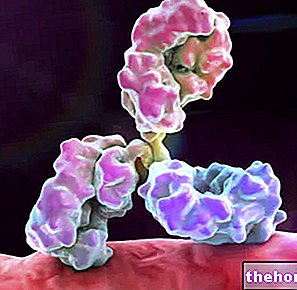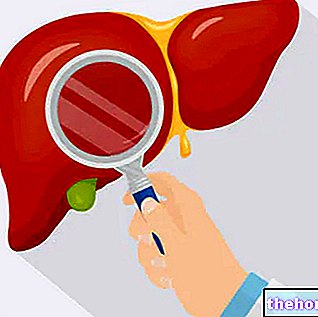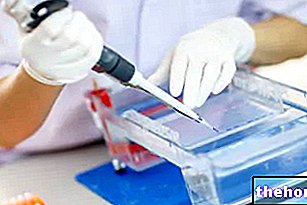Hypervolemic hypernatremia
Absolute excess of sodium in a blood very rich in water: it is the less common form of hypernatremia, typical consequence of an increased iatrogenic or alimentary introduction of sodium, or of its retention in the kidney.
Possible causes:
- infusion of hypertonic solutions of NaCl (sodium chloride) and NaHCO3 (sodium bicarbonate);
- increased sodium intake without adequate proportional water intake (ingestion of sodium chloride per os - cooking salt, intake of emetics rich in sodium chloride, ingestion of sea water, enteral and parenteral artificial nutrition with hypertonic preparations, saline enemas hypertonic, intrauterine injections of hypertonic saline preparations, intake of inadequately diluted infant formula, etc.);
- hypertonic dialysis (accidental modification of the dialysate);
- prolonged corticosteroid therapy → corticosteroids increase sodium retention;
- primary hyperaldosteronism (Conn's disease → pathology of the adrenal glands characterized by an "excessive production" of the hormone aldosterone, which increases the reabsorption of sodium in the kidney, favoring the elimination of potassium);
- hyperadrenocorticism (Cushing's syndrome) → cortisol reduces sodium losses in the intestine.
The excess of blood (hypervolemia) is associated with hypertension, which favors the escape of water and sodium from the vessel lumen → increase of water and sodium in the extracellular compartment with the appearance of the typical symptoms of hypervolemia: edema and hypertension.
Normovolemic or euvolemic hypernatremia
Relative excess sodium in normal or slightly reduced blood volume: This is the typical consequence of a lack of water intake or a loss of water without a change in total body sodium. In similar conditions, there is a movement of water from the intracellular to the extracellular compartment, which tends to keep the volume around normal or slightly below normal values (over time, hypervolemic hypernatremia tends to develop). Most conditions of normovolemic hypernatremia occur in paediatrics and geriatrics, where the water supply often depends on others.
The main causes of normovolemic hypernatremia include:
- diabetes insipidus: excessive excretion of water in the kidney due to inadequate production of vasopressin by the neurohypophysis (neurogenic diabetes) and / or reduced sensitivity to its action (nephrogenic diabetes); vasopressin is a hormone that acts in the kidney by stimulating the reabsorption of water and opposing diuresis
- iatrogenic causes
- hypodipsia / adipsia (reduction or absence of thirst with insufficient water intake)
- water shortage, inability to get water
The water losses can be extrarenal (skin, respiratory tract) and in this case the urine will be particularly concentrated (high urinary osmolarity), or renal and in this case the urine will be diluted (reduced urinary osmolarity). In any case, the presence of edema is not recorded in normovolemic hypernatremia.
Hypovolemic hypernatremia
Relative excess of sodium in a reduced blood volume: this is the typical consequence of marked dehydration with loss of hypotonic fluids (eg vomiting, sweat, diarrhea), such that water depletion exceeds that of sodium in percentages. Consequently, the aqueous component of the blood is reduced and the blood sodium is concentrated.
The main causes of hypovolemic hypernatremia include:
- vomiting, watery diarrhea
- adipsia / hypodipsia
- fever
- extreme sweating and hyperventilation
- chronic nasal discharge
- urinary obstruction
- hyperglycemic glucosuria
- diuretics
- osmotic diuresis (hyperglycemia, urea, mannitol)
- IRA, IRC
- fluid loss in the third space
- burns
Reduced blood volume (hypovolaemia) is associated with symptoms such as orthostatic hypotension, decreased skin turgor, dry mucous membranes, collapsed neck veins and tachycardia. DEHYDRATION → HYPERTONICITY OF THE EXTRACELLULAR FLUID → INTRACELLULAR DEHYDRATION (water moves from intracellular to extracellular spaces)
Joint assessment of natriuria (sodium concentration in urine) can help determine whether the losses are primarily renal or extrarenal:
HYPERVOLEMIC FORMS
- natriuria> 20 mmol / L, with increased osmolality and urine specific gravity, and polyuria
HYPOVOLEMIC FORMS
- natriuria> 20 mmol / L: increased renal loss of hypotonic fluids, accompanied by polyuria
- natriuria oliguria or anuria
EUVOLEMIC FORMS
- reduced specific gravity natriuria → Renal Losses, Diabetes insipidus
- natriuria> 20 mmol / L: hypodipsia, accompanied by oliguria or anuria with high osmolarity and urine specific gravity → Extrarenal losses

Other articles on "Hypovolemic, Normovolemic, Hypervolemic Hypernatremia"
- Hypernatremia
- Hypernatremia: Symptoms and Therapy




























